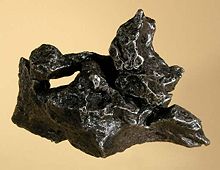Campo del Cielo crater
| Campo del Cielo | |
|---|---|

Campo del Cielo iron meteorite with natural hole, 576 grams
|
|
| Type | Iron |
| Structural classification | Octahedrite |
| Group | IAB |
| Composition | 92.9% Fe, 6.7% Ni, 0.4% Co |
| Country | Argentina |
| Region | Chaco Province and Santiago del Estero Province |
| Coordinates | 27°38′S 61°42′W / 27.633°S 61.700°WCoordinates: 27°38′S 61°42′W / 27.633°S 61.700°W |
| Observed fall | No |
| Fall date | 4,000–5,000 years ago |
| Found date | <1576 |
| TKW | >100 tonnes |
| Strewn field | Yes |
The Campo del Cielo refers to a group of iron meteorites or to the area where they were found. This area is situated on the border between the provinces of Chaco and Santiago del Estero, 1,000 kilometers (620 mi) northwest of Buenos Aires, Argentina. The crater field covers an area of 3×18.5 kilometers and contains at least 26 craters, the largest being 115×91 meters. The craters' age is estimated as 4,000–5,000 years. The craters, containing iron masses, were reported in 1576, but were already well known to the aboriginal inhabitants of the area. The craters and the area around contain numerous fragments of an iron meteorite. The total weight of the pieces so far recovered is about 100 tonnes, making the meteorite posibly the heaviest one ever recovered on Earth.
The largest two fragments, the 37-ton El Chaco and 30.8-ton Gancedo, are among the heaviest single-piece meteorite masses recovered on Earth, along with the 60-ton Hoba and a 31-ton fragment of the Cape York meteorite.
In 1576, the governor of a province in Northern Argentina commissioned the military to search for a huge mass of iron, which he had heard that Natives used for their weapons. The Natives claimed that the mass had fallen from the sky in a place they called Piguem Nonralta which the Spanish translated as Campo del Cielo ("Field of Heaven"). The expedition found a large mass of metal protruding out of the soil. They assumed it was an iron mine and brought back a few samples, which were described as being of unusual purity. The governor documented the expedition and deposited the report in the Archivo General de Indias in Seville, but it was quickly forgotten and later reports on that area merely repeated the Native legends. Following the legends, in 1774 don Bartolome Francisco de Maguna rediscovered the iron mass which he called el Meson de Fierro ("the Table of Iron"). Maguna thought the mass was the tip of an iron vein. The next expedition, led by Rubin de Celis in 1783, used explosives to clear the ground around the mass and found that it was probably a single stone. Celis estimated its mass as 15 tonnes and abandoned it as worthless. He himself did not believe that the stone had fallen from the sky and assumed that it had formed by a volcanic eruption. However, he sent the samples to the Royal Society of London and published his report in the Philosophical Transactions of the Royal Society. Those samples were later analyzed and found to contain 90% iron and 10% nickel and assigned to a meteoritic origin.
...
Wikipedia
